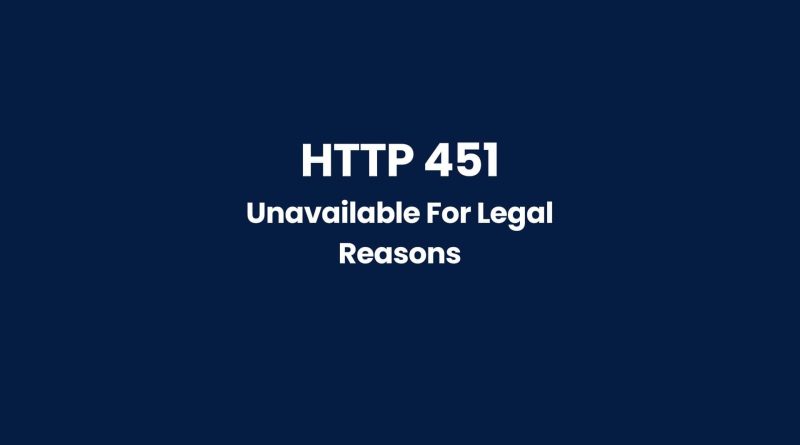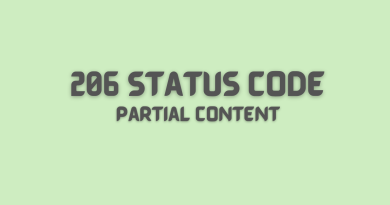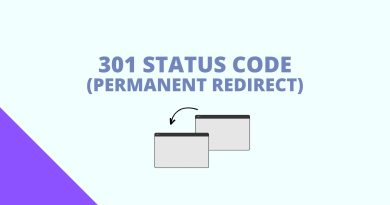What is HTTP 451 Unavailable For Legal Reasons: Ultimate Guide
The internet has become a critical part of many people’s lives, but there are certain places that remain inaccessible to the public. This is where HTTP 451 Unavailable For Legal Reasons comes in. It is an error code indicating that access to this content or website has been blocked due to legal reasons. But what exactly does it mean? This article will provide an ultimate guide on HTTP 451 and what it means for users around the world.
The rise of the internet has presented challenges when it comes to regulating information available online. In order to protect user data and privacy, countries have adopted laws restricting the availability of certain websites and materials. As a result, webmasters must comply with these regulations by blocking access to potentially restricted content—this is where HTTP 451 steps in as a form of censorship control.
HTTP 451 ‘Unavailable For Legal Reasons’ provides webmasters with a way to restrict access while still preserving their compliance with applicable local laws; however, understanding its implications can be complicated. This comprehensive guide aims to demystify this issue by breaking down the specifics of HTTP 451 so readers can better understand why some sites may remain off-limits despite being just one click away from view.
What Is HTTP 451 Status Code?
HTTP 451 is an HTTP status code known as “Unavailable For Legal Reasons” which belongs to client error responses. It occurs when a proxy server or user’s browser disallows access to web pages deemed illegal under certain legal norms. This means that resources hosted on the servers are deemed unavailable for legal reasons and the user cannot access them due to a legal demand from authorities. As such, it serves as a warning message informing users of the unavailability of requested resources due to their illegality.
The purpose of this http status code is two-fold:
Firstly, to protect internet users by preventing them from accessing potentially illegal websites;
Secondly, to prevent online service providers from serving content that could be considered illegal in some jurisdictions. By using this http status code, service providers can avoid potential prosecution and provide an extra layer of security against malicious attacks – making sure only legitimate traffic reaches their servers.
It should be noted that while HTTP 451 provides an effective way of protecting both users and service providers from unwanted consequences associated with hosting or accessing potentially illegal material, it does not guarantee complete immunity from all potential liabilities arising out of its misuse. Therefore, caution must be taken whenever dealing with any type of legal issues related to the internet. Transitioning into subsequent sections about cause of http 451 error will further explore these issues in more detail.
Cause Of HTTP 451 Error
HTTP 451 is an error code that indicates the web page requested by a user is unavailable for legal reasons. It was proposed as a standard in 2010, but only recently adopted by some western web services. This status code has created changes to how HTTP error codes are displayed and interpreted on the internet.
There are various legal obstacles that may lead to this message being displayed. These include censorship laws or copyright restrictions which prohibit access of certain content on the web. The Error Message can vary depending on the country where it’s triggered, with Lex Julia providing one example of a message indicating unavailability due to court orders.
The implications of this http status code have been far-reaching, offering users more information beyond simply ‘page not found’ when browsing online; giving them the ability to see if their request is blocked due to any kind of legal issue within their location. As such, further understanding of these errors and what causes them will become increasingly important for many readers across the world. Transitioning away from vague error messages towards specific ones helps give citizens insight into why they cannot access certain websites – something that until now remained ambiguous and potentially oppressive.
Server Side Or Client Side Issue?
The discussion of the HTTP 451 error code’s server-side or client-side issue begins by considering the legal reasons link. This particular response code is formally proposed as a reference to Ray Bradbury’s ‘Fahrenheit 451’, and it relates to online censorship due to applicable legislation or court orders. In other words, web browsers may receive this error when content has been blocked by a third party in compliance with such laws.
When users face an HTTP 451 response body, they are presented with an “unavailable for legal reasons” message that informs them that access is denied based on certain regulations. It should be noted that no further details about the blocking entity are provided; this leaves many wondering if the action was taken by their internet service provider (ISP), host server, or even government forces.
One of the main reasons for an HTTP 451 Unavailable For Legal Reasons response is when content violates privacy law or other laws set by governing bodies. This could mean attempting to access content on a page that would violate copyright, or using a party-making website without permission from all parties involved. The DNS provider may also block certain content types if they are deemed illegal in particular countries – this is becoming more common practice around the world as new privacy laws come into force.
How To Fix HTTP 451 Error Code
Use a VPN or proxy server
Using a virtual private network (VPN) or proxy server is a potential solution for accessing resources that are restricted due to geographical location. These services can help you bypass geographical restrictions by routing your internet traffic through a server in a different location. Here are some additional details about using a VPN or proxy server to fix the HTTP 451 error:
- When you use a VPN or proxy server, your internet traffic is routed through a server located in a different location than your own. This makes it appear as if your internet connection is coming from a different location, which can help you bypass geographical restrictions that may be causing the HTTP 451 error.
- There are many VPN and proxy server services available, so it’s important to choose one that meets your needs. Some factors to consider when choosing a service include the location of their servers, the level of encryption they offer, and their privacy policy.
- Setting up a VPN or proxy server: Setting up a VPN or proxy server typically involves installing software or configuring settings on your device. Many VPN and proxy server services offer step-by-step instructions or support to help you set up the service.
- VPN and proxy server services vary in price, with some services offering free plans and others requiring a subscription fee. It’s important to read the service’s terms and conditions to understand the costs involved and any limitations of the service.
- While using a VPN or proxy server can help you bypass geographical restrictions and access the resource you need, there are some potential drawbacks to consider. These include slower internet speeds, potential privacy concerns if the service logs your internet activity, and the possibility that the service may be blocked by the entity responsible for the restriction.
Change Your DNS Resolvers
DNS resolvers are responsible for translating domain names into IP addresses. When you enter a domain name in your web browser, the resolver sends a request to a DNS server to obtain the IP address associated with that domain. If the resolver fails to connect to the DNS server or the server returns an error, you may encounter an HTTP 451 error.
To change your DNS resolvers, you can follow these steps:
- Determine your current DNS resolvers: You can find your current DNS resolvers by running the command “ipconfig /all” on Windows or “ifconfig -a” on Unix/Linux/Mac. Look for the “DNS Servers” entry to see the IP addresses of your current resolvers.
- Choose new DNS resolvers: You can choose a public DNS resolver, such as Google DNS (8.8.8.8 and 8.8.4.4) or Cloudflare DNS (1.1.1.1 and 1.0.0.1), or use your ISP’s DNS resolver if they provide one.
- Change the DNS resolvers: Once you have chosen new DNS resolvers, you can change them in your network settings. On Windows, go to “Control Panel” > “Network and Internet” > “Network and Sharing Center” > “Change adapter settings”. Right-click on your network connection and select “Properties”. Select “Internet Protocol Version 4 (TCP/IPv4)” and click “Properties”. Select “Use the following DNS server addresses” and enter the IP addresses of your new resolvers. On Unix/Linux/Mac, you can edit the /etc/resolv.conf file to update the DNS resolvers.
After changing the DNS resolvers, try accessing the website again to see if the HTTP 451 error is resolved. If the error persists, you may need to contact the website owner or your ISP for further assistance.
Enable HTTPS
Enabling HTTPS may help resolve an HTTP 451 error, as this error can sometimes occur due to a lack of security measures on the website.
HTTPS (Hypertext Transfer Protocol Secure) is a secure version of the standard HTTP protocol that uses encryption to protect the communication between the web server and the client’s browser. When a website uses HTTPS, the data exchanged between the user’s browser and the server is encrypted, making it more difficult for hackers to intercept and access sensitive information.
If a website is not using HTTPS and is instead using unencrypted HTTP, it may be more susceptible to security vulnerabilities, such as data breaches or attacks that compromise the website’s availability. This can lead to an HTTP 451 error if the website owner has chosen to block access to the website for legal or other reasons.
To enable HTTPS on a website, the website owner can obtain an SSL (Secure Sockets Layer) or TLS (Transport Layer Security) certificate from a trusted certificate authority (CA) and install it on the web server. Once the certificate is installed, the website will use HTTPS instead of HTTP, and the data exchanged between the user’s browser and the server will be encrypted and secure.
Enabling HTTPS on a website may help resolve an HTTP 451 error, as the added security measures may help satisfy any legal or security requirements that may be necessary for accessing the website. If you encounter an HTTP 451 error on a website, you can check if the website is using HTTPS and contact the website owner to ask about enabling HTTPS if it is not already in use.
Contact the website owner or your ISP
If changing your DNS resolvers does not resolve the HTTP 451 error, you may need to contact the website owner or your internet service provider (ISP) for further assistance.
When you encounter an HTTP 451 error, it usually means that the website is unavailable due to legal reasons, such as censorship or a court order. In this case, the website owner may have intentionally blocked access to the website or the website may be inaccessible due to legal restrictions in your location. In this case, there may not be much that you can do except to contact the website owner to ask about the issue or find an alternative website to access the content you need.
Alternatively, the HTTP 451 error may be caused by a technical issue on the website or a problem with your internet connection. In this case, you can try accessing the website from a different device or network to see if the issue persists. If the problem is still there, you can contact your ISP to ask about any network issues that may be affecting your connection. The ISP may be able to provide you with additional information or troubleshoot the issue to resolve the HTTP 451 error.
When contacting the website owner or your ISP, be sure to provide as much information about the issue as possible, including any error messages or screenshots you have encountered. This will help them to identify the problem more quickly and provide a more accurate solution.
Similar Http Status Codes To 451
The HTTP 451 Error Code is a rare occurrence, but understanding similar status codes can provide valuable insight. Lex should be familiar with the 403 Forbidden and 404 Not Found messages when navigating the web; however, an even longer-term identifier exists: HTTP 451 Unavailable for Legal Reasons. This code indicates that servers have deemed it legally forbidden to service in the Roman resource requested by the user due to restrictions or regulations.
Detailed instructions are necessary for users who experience this error message, as there may be instances where a site is unavailable without breaking any laws. In such cases, HTTPS 419 Unknown Status is used instead of HTTP 451 Unavailable for Legal Reasons. The difference between them lies in whether access to a page has been blocked due to legal reasons or if it simply no longer exists on the server.
When dealing with an HTTP Error Code, extensive research needs to be done before determining why access was denied and how to fix it. Knowing when a website is legally permitted or not can help identify which steps need to be taken next in order to gain access again—or at least determine why entry was denied in the first place. Understanding different status codes will go a long way toward helping make sure all user requests are serviced appropriately within their respective jurisdictions.
All HTTP status codes by categories
Informational responses
(100 – 199)



